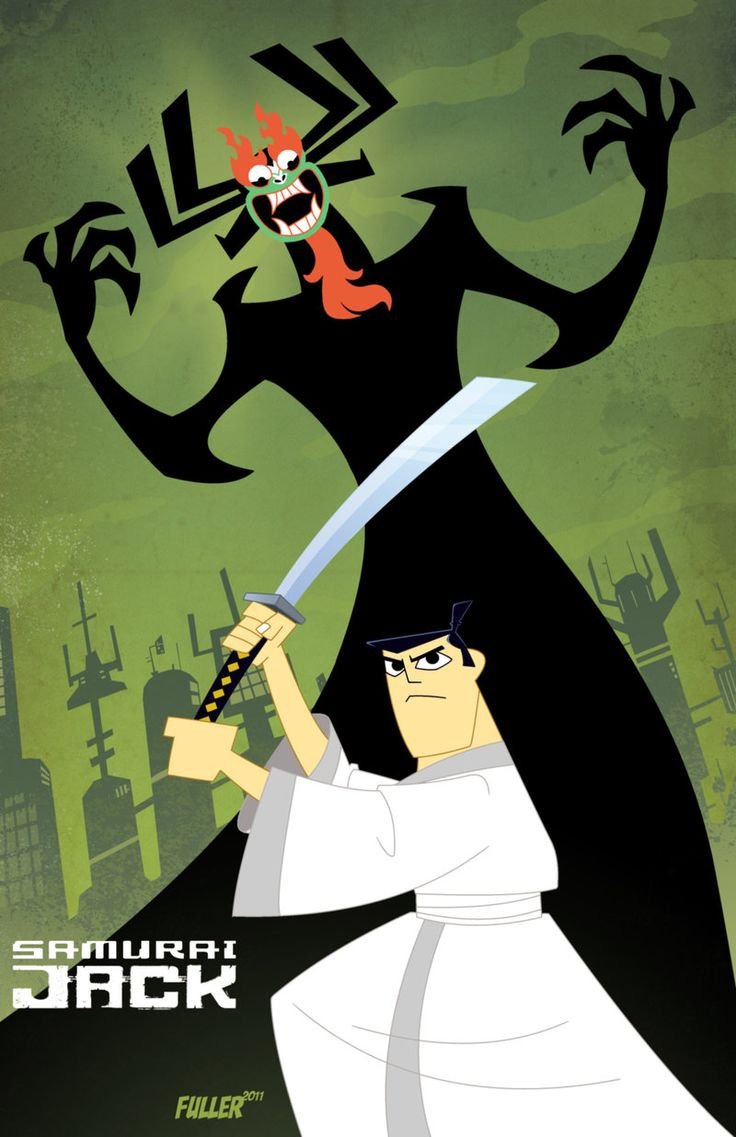Deconstructing ‘Samurai Jack’
Samurai Jack is an American animated TV series that premiered on Cartoon Network in 2001, running for a total of five seasons. The story follows the adventure of an unnamed samurai travelling through a dystopian future governed by the demonic wizard, Aku. What makes Samurai Jack unique is the moral paradigm that can be drawn from the central premise of its plot, neatly summarised by the tagline of the opening sequence: “Gotta get back, back to the past, Samurai Jack.”
The world that our titular samurai fights to destroy - a world corrupted at every level by Aku's evil - is unambiguously modern in character. When he is cast through a time portal at the end of the first episode, he falls out into a swirling maelstrom of bright lights and fast-moving alien objects, a world of towering black skyscrapers, massive electronic billboard advertisements, and sky-streets jammed with flying motorcars. The thunderous roar of the city's traffic disorients and terrifies him.
After barely surviving his dramatic entrance, he is greeted by some locals who give him the name “Jack”. When Jack hesitantly asks where he is, he is told by these odd strangers that he is in the “central hub” of “Sector D”. This is a placeless place, devoid of history or culture, and labelled the “hub” of a “sector” in a familiarly modern, soulless, and bureaucratic fashion.
Jack then stumbles into a seedy nightclub, which increases his distress considerably. He holds his hands to his ears, desperate to block out the thumping techno music, as he looks around wild-eyed at a room full of half-clothed dancers and hideous aliens with bionic body parts. This new world is too bright and too loud for Jack; it is vulgar, harsh and obnoxious against the tranquil flower-filled meadows, snow-capped mountains and rolling hills he is used to. Jack is a man out of time, questing through the future in order to return to the past. He fights to turn the clock back in order to prevent the world around him from ever existing, and to save the world he once knew. The tale of Samurai Jack is a reactionary, Luddite Odyssey.
The first scene of the first episode is like something out of a bad psychedelic trip. Everything is uncanny: the sun and moon are too large, the landscape is barren and red, and the lone piece of flora in the scene is a twisted black tree. The giant moon eclipses the sun, shooting red lightning through the sky as the tree twists and morphs into the demonic Aku. This terrifying moment, complete with suitably unsettling sound effects, masterfully introduces the show’s main antagonist. It is also a prime example of the show’s use of the environment, instead of dialogue, to evoke emotion and convey information about its characters, a technique oft-adopted by the show’s animation director, Genndy Tartakovsky.
Our main antagonist, Aku, is able to see Jack through a magic mirror at all times; he can shapeshift endlessly, and is immune to all physical weapons. Aku is more than a demon wizard – he is a malevolent god. His informant network, through which he instantly learns of Jack’s arrival in the future, extends into every nook and cranny of the show’s universe. His armies are inexhaustible, only dwarfed in size by the intergalactic mining operation that he employs to sustain them. The entire universe is in the grip of an Orwellian state, in the service of a God-like dictator. The central premise of the show itself implies the extent of Aku’s dominance, being so complete as to be utterly insurmountable, and, hence, only able to be defeated through time travel. Jack stands alone, armed only with a magic sword and the power of righteousness, and yet, somehow, it feels as though Aku fears him more than he fears Aku. In this children’s television show, Genndy Tartakovsky’s finest creation, we see our protagonist triumph in the face of seemingly hopeless odds, against an incomprehensibly awful antagonist, the figurehead of a seemingly all-powerful dystopian state.
For the first four seasons, Jack is an unchanging constant, whilst the setting around him is repeatedly changed in line with his journey. Dialogue and character development are conspicuously limited when compared with many similar shows, but this speaks to the genius of Samurai Jack’s unique formula. The relationship between the main character and the setting are reversed, as Jack forms the show’s unchanging stage. The story takes place around him, but he stays the same, dressed in his characteristic white robes, forever a fish out of water. The only exceptions to this come in the first episode, in which Jack’s character is established, and the final season on Adult Swim, which takes a different and more mature tack.
Tartakovsky’s work for Cartoon Network is understandably constrained by the limits of what is considered to be appropriate content for children, but, when the show was moved to Adult Swim, it became free to explore darker themes. For the first four seasons, which aired on Cartoon Network, Jack only turns his sword on his demonic and robotic opponents, allowing Tartakovsky to showcase his skill without depicting the, naturally more graphic, murder of human-appearing characters. As Jack’s opponents, until the final season, remain largely the robotic minions of Aku, rather than the flesh-and-blood inhabitants of his fallen world, this has the additional effect of casting Aku and his evil as industrial in character, in opposition to noble, agrarian Jack.
The entire show is hand-drawn, with the lack of outlines allowing the characters to blend into their backgrounds. Lineless drawings give the animation a rudimentary, child-like appeal, as well as greater flexibility with regard to proportions, so that all of the characters’ movements feel powerful and dynamic. Action scenes are one of the great strengths of Tartakovsky’s cartoons, as evident in his earlier Star Wars: The Clone Wars (2003), right through to Primal, which aired recently, in 2019. Combined with its hand-drawn style, the show’s use of comic book-esque screen framing makes the series feel more like a graphic novel come to life, or an anime series, than a Western children’s cartoon. Even more impressively, Samurai Jack accomplishes this without sacrificing the entertainment value for its young audience, with its small but varied set of wacky recurring characters keeping things light and funny.
What makes Samurai Jack stand out, in a sea of well-animated cartoons, is the story. Jack is a unique character that represents a sentiment not often explored in animated cartoons, particularly those primarily aimed at children: the sense of longing for a world you’re not even sure exists, or ever existed. The world around Jack is dystopian and evil, but was the world it has replaced ever truly as good as he remembers it to be? Was the world ever free of the corruption and evil that so disgusts him in the “world of Aku”? Jack’s sense of alienation is deeper than that of a stranger in a strange land: he is a man trapped at the wrong place in time entirely. Everything is laced with and governed by Aku’s evil; the very ground on which he walks, the air through which he moves, is hostile to him. In our world, where seemingly nothing can escape the plastic-coated grip of modernity, this cartoon explores what it feels like to long to “get back, back to the past, Samurai Jack.”

